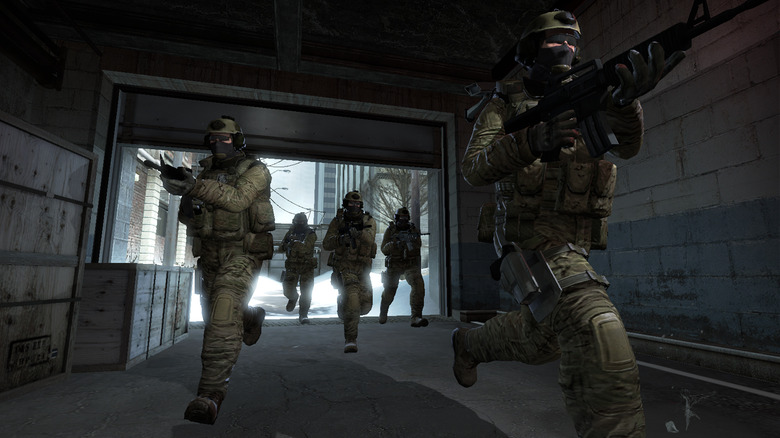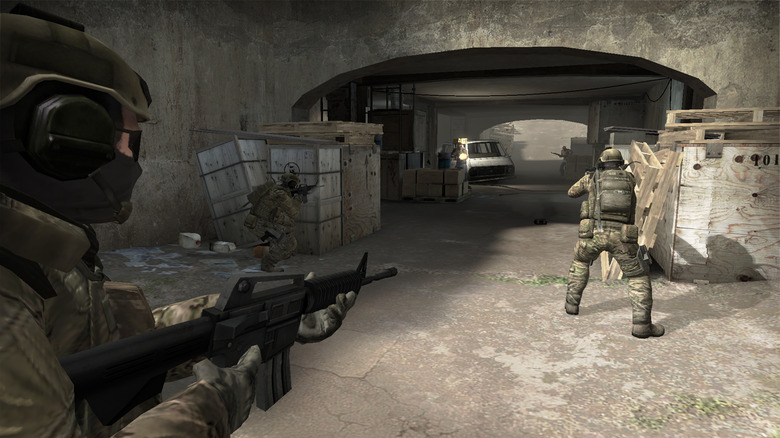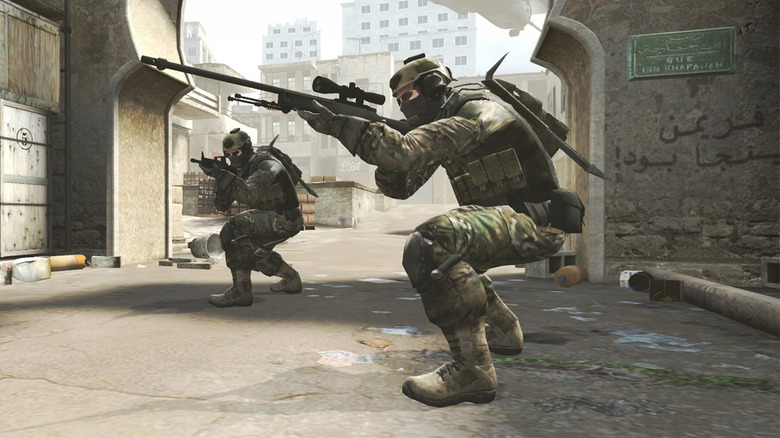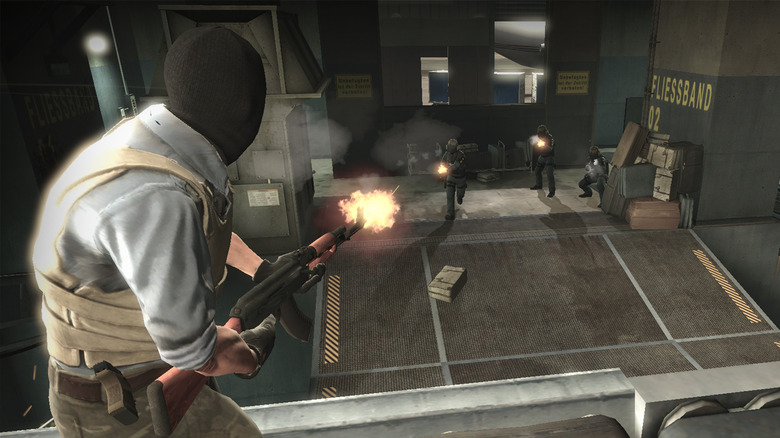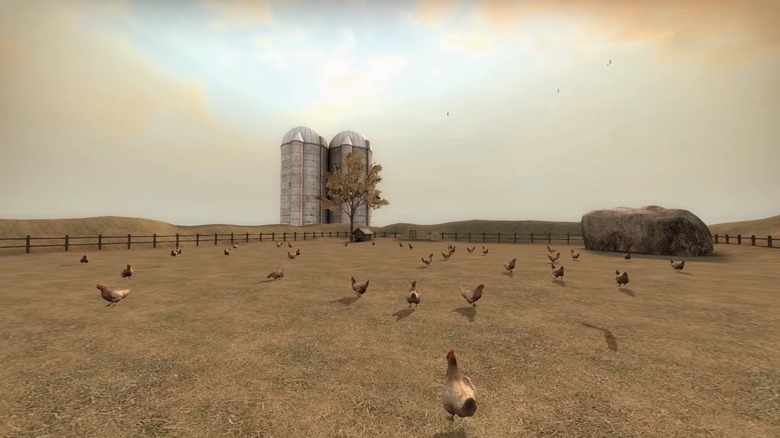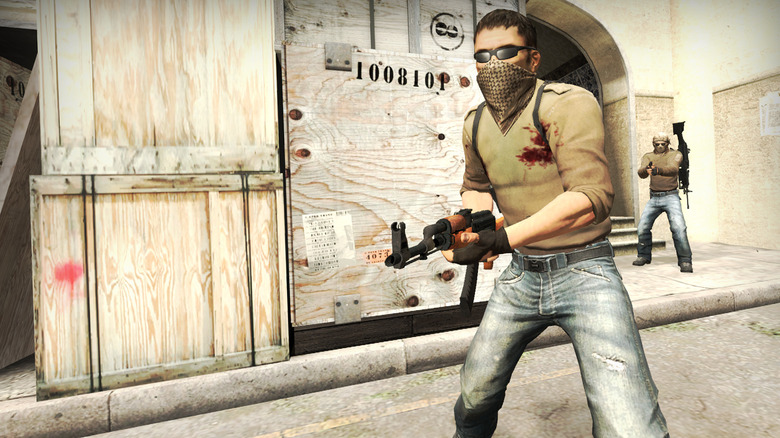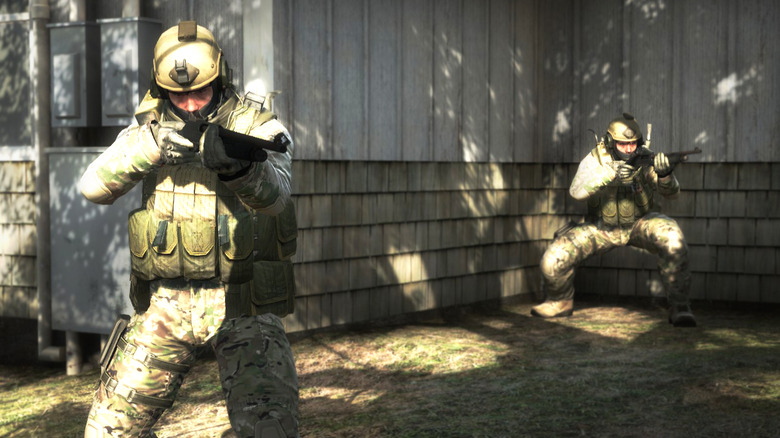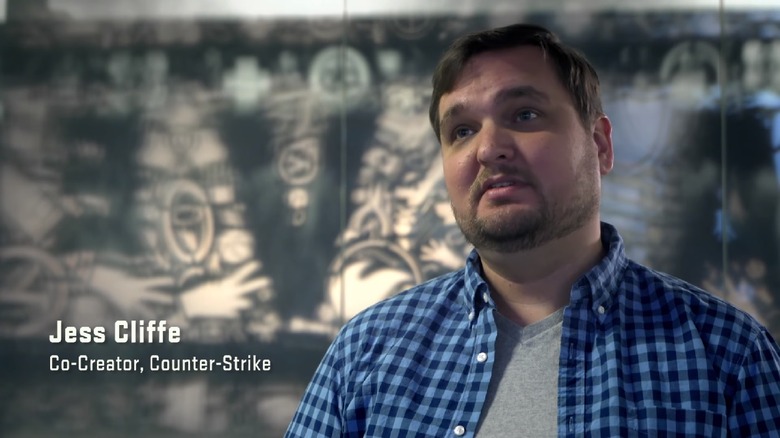The Untold Truth Of Counter-Strike
It's hard to believe, but Counter-Strike first hit the scene back in 1999. Created by Minh Le and Jess Cliffe as a mod to Valve's Half-Life, Counter-Strike quickly won over fans with its unique take on multiplayer and more realistic style than arena shooters like Quake and Unreal. It gained so much popularity, in fact, that Valve actually purchased the mod and shaped it into the esports juggernaut it is today.
The newest iteration, Counter-Strike: Global Offensive (also known as CSGO), still follows the same basic rules as the original mod. The game is still wildly popular on Steam, regularly sitting near the top of the Steam Charts next to games like Dota 2 and PlayerUnknown's Battlegrounds. And, despite the recent explosion of esports titles, Counter-Strike still stands as one of the most popular esports games out there. How has it managed to capture this level of longevity?
Today, let's take a look at some of the little details that make Counter-Strike tick. There's a lot of history here, and these are just some of the things you may not know about Valve's wildly popular shooter.
Counter-Strike's most iconic map owes its existence to Team Fortress 2
Dust is one of the most iconic maps tied to the Counter-Strike series, and its sequel, Dust2, sits alongside maps like Nuke and Inferno as a staple map of the professional scene. And, like many of the best things in life, the Dust maps owe their existence to a combination of thievery and time travel.
Dave Johnston started creating maps for the Counter-Strike mod of Half-Life in the mod's third update, and he wrote two extremely fascinating blog posts on the creation of Dust and Dust2. The developers of the Counter-Strike mod liked Johnston's work, and approached him with a texture artists to create something wholly original for the game. He pulled out an early screenshot for Valve's Team Fortress 2, which showed a level set in a small, Middle-Eastern town. He wanted to create a level similar to that screenshot, and soon got the textures to do so. The final map layout closely mirrors that early TF2 design, which never even made it into TF2 itself.
The most fascinating aspect of this entire story is the bizarre timeline involved. Dust quickly became a staple of the Counter-Strike pro scene upon its release, even though it was based off early screens of TF2. Team Fortress 2 itself, however, would not release until 2007, over five years AFTER the release of the Counter-Strike map.
Wrap your brain around that one, and raise a Sandvich to Counter-Strike's iconic desert map.
Counter-Strike's most powerful weapon used to pack an even bigger punch
Counter-Strike, like many esports titles, can be a bit daunting to someone who is just starting out. Learning how the economy works, where fights typically play out, good hiding spots, how to use grenades ... there's a lot to just getting started, and the only way to do it is to jump in and get killed. A lot. And a good amount of that killing will probably come from Counter-Strike's most feared weapon, the Arctic Warfare Police Rifle (AWP). Pronounce it as a one-syllable word, and learn to fear it in later rounds.
Unbelievably, the game's most powerful sniper rifle started out even more powerful.
People still complain that the AWP takes no skill; it is a sniper rifle with little sway or recoil, and it deals a massive amount of damage. However, in early builds of Counter-Strike, the AWP was so powerful that it could kill you in a single shot. Didn't matter where the bullet struck you: chest, arm, or leg, and you were dead.
Luckily, the AWP's power level was brought down over time, but it still remains the most feared gun in the game for a reason. And, even with the imposed power limits, there are still plenty of people complaining about it on Reddit and Steam.
Batten down the hatches - CSGO contains a bizarre dialect of English
As a global esports title, you would expect a game like Counter-Strike: Global Offensive to have several language options. This allows people all over the world to enjoy the game. Whether you speak English, Chinese, French, or Pirate, you will be able to ...
... wait, Pirate?
That's right; it isn't in the options menu, but you can still load this bizarre version of standard English into your CSGO games. Watch the video above to see instructions on how to enable the language, which involves putting in a console command as the game launches. If you speak English, you will still be able to understand what's happening ... sort of, matey. Yar! It changes the wording of a lot of different commands and in-game options, some of which are pretty funny: your in-game monetary units become "doubloons," the counter-terrorist team is renamed "the British Navy," etc.
It's not going to breathe new life into Counter-Strike for you or anything like that, but it's good for some laughs. Shiver me timbers!
Counter-Strike has gone through some scary match-fixing scandals
Wherever there is competition, there is gambling. And wherever there is gambling, people will try to fix the bets. It's not quite to the tune of the 1919 World Series, but professional Counter-Strike has gone through several match-fixing scandals, earning unscrupulous players thousands of dollars and causing several bans to be handed out.
The first major match-fixing incident in Counter-Strike is the iBuyPower vs. NetcodeGuides scandal of 2013. Kotaku writes that the match between the teams was fishy almost immediately, as IBP should have completely outgunned their opponents. Instead, they got waxed, and didn't seem too upset about it. A bit of investigation revealed that members of the team had created dummy accounts on gambling sites to bet against themselves, dealing a serious blow to the esports' then-tenuous credibility.
Dot Esports writes that low-level Counter-Strike tournaments are a hotbed for match-fixing, due to the payouts being so small compared to the gambling money a player can make. Valve regularly bans players from competing at majors, and there are (seemingly) constant investigations and allegations of teams throwing matches to cover spreads or staging upsets to collect huge payouts.
What we're saying is that you shouldn't rig your matches. If you want to get your serious gambling fix in, go bet on some pee-wee football or something. Like a normal person.
What, are you chicken?
Even a game as serious as Counter-Strike can have its humorous moments, and few things exemplify this as well as the chicken infestation on some of the game's maps. Originally, these chickens could serve as spotters, loudly squawking and alerting the opposing team to your presence if you moved too quickly around them. Although their loud reactions have since been toned down, there are still quite a few bizarre elements to your fowl-y friends.
Counter-Strike's chickens apparently celebrate holidays, as PC Gamer has showcased. They can be spotted in ugly Christmas sweaters, pumpkin masks, and ghost costumes, depending on if the game has been updated near a recent holiday.
Chickens sometimes doubled as secret service agents, taking bullets for players and reducing damage.
Perhaps best of all is the ability to tame a pet chicken and have it follow you about the map. If it is shot and killed, the game will tell you how long it survived, and the chicken will even appear at the spawn and continue following you if you survive the round in which you tame it. Talk about loyalty!
A legendary play got a portion of the map named after a player
There are some sports plays that just go down in history. Babe Ruth's called home run in the 1932 World Series. The immortalization of Franco Harris from the "Immaculate Reception." These are moments that have transcended their sport and seeped into general pop culture.
Counter-Strike has those moments, too.
Dave "Moto" Geffen was one of the first true superstars of Counter-Strike, a media-savvy player in an era where not many esports stars could manage that. He played for juggernaut squad Team 3D, and his team came up against Swedish squad SK in the 2004 World Cyber Games Championship. Moto went for a risky strategy that almost backfired catastrophically, but he snatched victory from the jaws of defeat and etched his name into Counter-Strike lore.
On the Inferno map, there are a few boxes that require a teammate to boost you in order to get out from behind them. After hiding there, Moto's entire team was killed, stranding him in his hiding spot. Unfortunately for SK's remaining four players, they didn't know where Moto was. While SK was busy trying to plant the bomb, Moto darted back and forth, quickly killing all four of his opponents — despite the fact that he had no way of escaping his hiding spot, so SK could simply have gone to the other site. To this day, the spot is still referred to as the "Moto Box."
Weapon skin gambling has caused plenty of controversy
There once was a time when things like loot boxes and paid cosmetic items didn't exist. PC Gamer writes that Counter-Strike: Global Offensive was one of the first esports titles to successfully create an in-game global economy based around cosmetic items, introducing weapon skins in their Arms Deal update back in 2013. Allowing players to buy and sell skins on the Steam Marketplace has netted Valve a pretty penny, and it has also given rise to some extremely controversial websites: the so-called CSGO gambling industry.
These websites allow players to wager their weapon skins in games of chance, offering the possibility to earn more valuable (and expensive) in-game items. The most notorious of these sites was CSGO Lotto, which was promoted by popular YouTubers Trevor "TmarTn" Martin and Tom "Syndicate" Cassel in videos where they would wager huge amounts of skins and (often) receive huge payouts.
The controversy stemmed from the fact that the two actually owned the site and never disclosed it, setting up a massive conflict of interest from a legal standpoint.
Polygon reports that the pair managed some legal trickery to avoid serious penalties, but sites like CSGO Lotto and their owners now must be much more wary of how they approach their business model. As long as cosmetic skins continue making serious money, however, don't expect them to go away any time soon.
One of the game's co-creators was arrested for an awful crime
Minh Le and Jess Cliffe created the original Counter-Strike mod way back in 1999, and both men were brought in to join Valve when the company purchased the mod in order to release it as a stand-alone game. Le left to join a Korean development studio in 2008, but Cliffe remained employed at Valve until very recently. The circumstances surrounding his dismissal in early 2018 are pretty ugly, however.
Cliffe was arrested by Seattle police on February 1, 2018, and the information surrounding the situation was murky for a few days. It wasn't long afterwards that it came out the Cliffe had paid an underage girl for sex, and the two had had multiple encounters with one another. Valve quickly suspended Cliffe, and the circumstances only got stranger, as Kotaku reports.
Cliffe's attorney is arguing that the two met on an adult website, so he had been deliberately misled to the girl's age. She claims that Cliffe recorded their encounters without her permission, and was afraid that violence would ensue if she did not continue to see him. As of this writing, Cliffe is still awaiting trial, and it is unknown what other information about this gross situation might come out.

